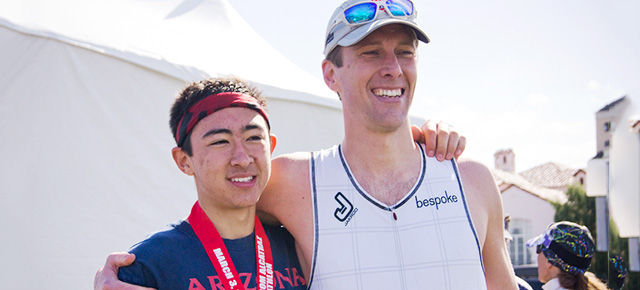
Senior Landon Hart and Aragon U.S. History teacher Will Colglazier dove into the icy waters of the bay from a boat next to Alcatraz on March 3 at 7:30 a.m. “The initial jump off the boat was so cold it was hard to breathe,” says Hart on the start of the race. “But you gotta move fast. After the beginning, the swim got better.” The waters are so cold that use of a wetsuit is required. “You basically have to wear one since the water is like 50 degrees,” says Hart. Colglazier comments, “You have no warm up for the swim. You jump right in, which is a daunting thing.” The swim is naturally the most dangerous part of the triathlon, considering drowning and hypothermia are risks. Many swimmers need to have assistance early on in the race due to the conditions in the water. Tragically, a person died this year during the swimming portion.
The conditions on the day of the race were tough. “The combination of wind and current made it a rocky swim. It was hard to get a rhythm,” says Colglazier. The swimmers have to swim from Alcatraz to the shore, totaling about 1.5 miles in distance. They had to swim at an angle in order to go in the right direction against the current. This necessary strategy actually worked against Colglazier time. He says, “I was too aggressive in the way I angled my swim, so I ended up having to take a perpendicular route.” Landon and Colglazier completed the swim, the shortest leg of the entire race, in approximately 40 minutes. Colglazier’s swimming time was seven minutes slower than his previous swimming split when he did the Escape race three years ago, which goes to show how comparing times year to year can be untelling of true performance. While Colglazier finished one minute slower than he did three years ago, his running was at a 7:30 pace compared to an 8:15 pace last time, and he finished 111th overall as compared to in the 300-400s last time.
After the swim, the race continued with an 18 mile bike ride in the scenic Marina Green, accompanied with views of Alcatraz and the Golden Gate. Hart says, “The bike was hilly, but I felt fine through it.” The bike starts on Marina Boulevard near the Golden Gate and eventually goes around Golden Gate Park and back. After returning to the Marina Green where the bike began, the triathletes began the run portion of the event.
The run was eight miles, longer than the standard Olympic distance and made even tougher with the 400 step Equinox Sand Ladder, a trademark aspect of the run on the Escape course. Hart says, “The run’s first four miles were fine, but then you hit the sand ladder and that takes a lot of energy. I felt low on energy the last 2 miles, but I was relieved and happy to finish.” The run took about an hour for Colglazier and Hart, who wavered between a 7.5-8 minute mile pace across the hilly course and Sand Ladder after already having raced for at least an hour and a half.
The race includes every range of skills, bringing people from all over the world, both amateur and professional. Colglazier says, “One of the cool things is you get to race alongside the professionals. There is no staggered start, so everyone starts at once. You get see the pain on their faces and hear them breathe as they go by you on their way back on the circuits.”
On the topic of training for his race, Colglazier says, “I [did] 2 workouts a day, either a bike and run or a swim and lift. Some days I [was] in the pool by 5:45, doing a workout before the workday starts.” Colglazier explains how training works alongside his teaching and family responsibilities: “My triathlon competition goes third on the list, behind my family and career.” For example, Colglazier does his biking workout, which can take up to an hour and 20 minutes, after his son goes to bed.
Hart and Colglazier had a pre-race collaboration as a result of their student-teacher relationship. Hart says, “I was really happy that Mr. Colglazier was competing. He gave me advice for the triathlon. He told me how to race the course since he’s done it before, like where to look on the swim in the distance so the current doesn’t pull you off the line. He gave me some training tips too.”
Colglazier finished impressively in a time of two hours and 49 minutes at approximately 10:30 a.m., a great feat for a time of the day when many people are still sleeping. Landon too accomplished the heroic feat, finishing at 10:50 a.m. with a time of 3 hours and 16 minutes. Landon took 564th in the whole race and 4th in the 17-19 year old division. Colglazier took 111th place in the whole race and 16th in the 30-34 year old division.
1580 individuals and many groups completed the race, representing more than 35 countries.
